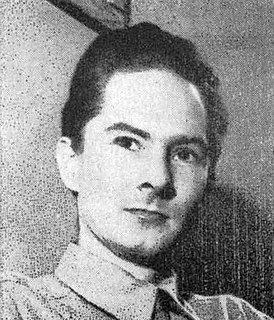
Benjamin William Bova is an American writer. He is the author of more than 120 works of science fact and fiction, he is six-time winner of the Hugo Award, a former editor of Analog Magazine, a former editorial director of Omni; he was also president of both the National Space Society and the Science Fiction Writers of America. He lives in Florida.

Harlan Jay Ellison was an American writer, known for his prolific and influential work in New Wave speculative fiction, and for his outspoken, combative personality. Robert Bloch, the author of Psycho, described Ellison as "the only living organism I know whose natural habitat is hot water".

Science fiction is a genre of speculative fiction that typically deals with imaginative and futuristic concepts such as advanced science and technology, space exploration, time travel, parallel universes, and extraterrestrial life. It has been called the "literature of ideas", and often explores the potential consequences of scientific, social, and technological innovations.

Anne Inez McCaffrey was an American-Irish writer known for the Dragonriders of Pern science fiction series. She was the first woman to win a Hugo Award for fiction and the first to win a Nebula Award. Her 1978 novel The White Dragon became one of the first science-fiction books to appear on the New York Times Best Seller list.

The Astounding Award for Best New Writer is given annually to the best new writer whose first professional work of science fiction or fantasy was published within the two previous calendar years. It is named after Astounding Science Fiction, a foundational science fiction magazine. The award is sponsored by Dell Magazines, which publishes Analog.

Asimov's Science Fiction is an American science fiction magazine which publishes science fiction and fantasy named after science fiction author Isaac Asimov. It is currently published by Penny Publications. From January 2017, the publication frequency is bimonthly.

Drexel Jerome Lewis Bixby was an American short story writer and scriptwriter. He wrote the 1953 story "It's a Good Life" which was the basis for a 1961 episode of The Twilight Zone and which was included in Twilight Zone: The Movie (1983). He also wrote four episodes for the Star Trek series: "Mirror, Mirror", "Day of the Dove", "Requiem for Methuselah", and "By Any Other Name". With Otto Klement, he co-wrote the story upon which the science fiction movie Fantastic Voyage (1966), television series, and novel by Isaac Asimov were based. Bixby's final produced or published work so far was the screenplay for the 2007 science fiction film The Man from Earth.

Gold: The Final Science Fiction Collection is a 1995 collection of stories and essays by American writer Isaac Asimov. The stories, which comprise the volume's first half, are short pieces which had remained uncollected at the time of Asimov's death. "Cal" describes a robot that wishes to write, and the title story "Gold" expresses both Asimov's admiration of King Lear and his thoughts on cinema adaptations of his own stories. The story "Gold" won a Hugo Award.
A listing of the Pulitzer Prize award winners for 1998:
Jay Williams was an American author of science fiction, fantasy, historical fiction, non-fiction, and radical theatre.

Colin John McCahon was a prominent New Zealand artist whose work over forty-five years consisted of various styles including landscape, figuration, abstraction and the overlay of painted text. Along with Toss Woollaston and Rita Angus, McCahon is credited with introducing modernism to New Zealand in the mid twentieth century. He is regarded as New Zealand's most important modern artist, particularly in his landscape work.

Joseph Edward "Jay" Lake, Jr. was an American science fiction and fantasy writer. In 2003 he was a quarterly first-place winner in the Writers of the Future contest. In 2004 he won the John W. Campbell Award for Best New Writer in Science Fiction. He lived in Portland, Oregon, and worked as a product manager for a voice services company.

Albedo One is an Irish horror, fantasy and science fiction magazine founded in 1993 and currently published by Albedo One Productions.

MonkeyBrain Books is an independent American publishing house based in Austin, Texas, specialising in books comprising both new content and reprinting online, international, or out-of-print content, which show "an academic interest," but which "reach a popular audience as well."

The Planet Savers is a science fantasy novel by American writer Marion Zimmer Bradley, part of her Darkover series. It was first published in book form in English by Ace Books in 1962, dos-à-dos with Bradley's novel The Sword of Aldones. The story first appeared in the November 1958 issue of the magazine Amazing Stories. It subsequently appeared in a German translation in 1960 with additional chapters added that were not by the author.
Fitzclarence Anstey John Caselberg was a New Zealand writer.

The Nebula Awards annually recognize the best works of science fiction or fantasy published in the United States. The awards are organized and awarded by the Science Fiction and Fantasy Writers of America (SFWA), a nonprofit association of professional science fiction and fantasy writers. They were first given in 1966 at a ceremony created for the awards, and are given in four categories for different lengths of literary works. A fifth category for film and television episode scripts was given 1974–78 and 2000–09, and a sixth category for game writing was begun in 2018. In 2019 SFWA announced that two awards that were previously run under the same rules but not considered Nebula awards—the Andre Norton Award for Middle Grade and Young Adult Fiction and the Ray Bradbury Award for Outstanding Dramatic Presentation—were to be considered official Nebula awards. The rules governing the Nebula Awards have changed several times during the awards' history, most recently in 2010. The SFWA Nebula Conference, at which the awards are announced and presented, is held each spring in the United States. Locations vary from year to year.
Myer Caselberg was a New Zealand storekeeper, businessman and local politician. He was born in Gaorah, Poland in 1841. He was Mayor of Masterton from 1886 to 1888.
Anna Margaret Frances Caselberg was a New Zealand painter.
Jay Telotte is a professor in the School of Literature, Media, and Communication at the Georgia Institute of Technology. With over 150 published scholarly articles and 10 published books, his area of expertise lies in film studies. His primary field of study is film history and genres, and he is particularly involved in the studies of science fiction. In his book Animating the Science Fiction Imagination, Telotte combines his interest in the science fiction genre and animation to explore the intersection between the two.













